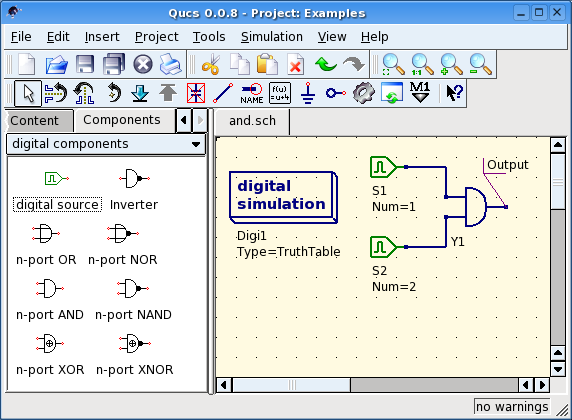
Readers will have probably noticed from the list presented above that multi-port S-parameter modelling and RF simulation featuresĪre not implemented in Qucs-S. Where needed each of the above can make use of Octave scripts and functions in the analysis of simulation data.
A range of lumped RF and microwave components for use in high frequency circuit design (limited but growing support). Emulation of Qucs RFEDD components (limited support at this time). Large signal AC transient simulation with steady state shooting methods (SPICE OPUS only). Single and multi-tone large signal AC Harmonic Balance simulation (Xyce only). network simulation/analysis (Ngspice and SPICE OPUS) Small signal AC two port S-parameter simulation (Ngspice, XYCE and SPICE OPUS). The central features of the spice4qucs RF elements are: The Qucs-S version of Qucs includes spice4qucs extensions which allow the package to be used for analysis of RF circuits. The idea of a predefined Test Bench isĪlso outlined and applied to RF circuit simulation case studies. To demonstrate these new featuresĪ number of example RF circuit simulations are presented together with a new Template element which allows libraries of analysisĪnd post-simulation data processing Nutmeg scripts to be stored and embedded in Qucs schematics. In this chapter the Qucs-S RF capabilities are introduced and described. HB is particularly suited to the simulation of analogue RF and microwave circuits. Or frequency modulated communications signals. Transient analysis can take a long time to reach a steady state solution due to widely differing frequency signals present in a circuit, for example amplitude In practice the HB simulation technique is often more efficient than transient analysis, particularly in situations where This source can be a large signal AC signal. Of circuit voltages and currents when signals reach a steady state, following excitation with an external signal source. In HB simulation, the voltages and currents in a nonlinear circuit are represented by truncated Fourier series. HB is a circuit simulation method that solves for the steady state solution of nonlinear circuits in the frequency domain. Via the spice4qucs extension, makes the Qucs-S version of Qucs a useful addition to the GPL RF circuit simulation scene. These RF simulation techniques, when coupled with the fact that Ngspice, Xyce and SPICE OPUS support small signal AC two port network analysis Simulation (Xyce) and a transient simulation shooting method (SPICE OPUS) for large signal AC steady state simulation. These include single tone and multi-tone HB With features which are designed specifically for RF circuit simulation. 
In contrast to SPICE 3f5 the Ngspice, Xyce and SPICE OPUS GPL simulators have been extended At RF, Qucs implements models and analysis features not included in the traditional SPICE 2g6Īnd 3f5 circuit simulators. The performance of high frequency circuits. Microstrip and coplanar technology components, making the package a good choice for investigation Interested in RF circuit design Qucs is distributed with a selection of built-in RF component models, including Package with good high frequency analysis capabilities like small signal AC two port and multi-port S parameterĪnalysis, noise analysis and rudimentary single tone Harmonic Balance (HB) circuit simulation. Today, Qucs has become a relatively stable simulation
#UJT SIMULATION QUCS SIMULATOR#
RF circuit simulator which was freely available to all interested in RF and microwaveĬircuit and system design. The original motivation behind the development of Qucs was the need for an open source Qucs-S/Octave circuit simulation and device parameter extraction interface.The SPICE OPUS large signal AC steady state transient shooting method.Multi-tone Large signal AC HB simulation.Single tone large signal AC Harmonic Balance simulation.Small signal AC two port network simulation/analysis.
 RF simulation with Ngspice, Xyce and SPICE OPUS. Verilog-A compact semiconductor device modelling. Introduction to mixed analogue/digital simulation.
RF simulation with Ngspice, Xyce and SPICE OPUS. Verilog-A compact semiconductor device modelling. Introduction to mixed analogue/digital simulation. 
XSPICE user written device models and library. Qucs and SPICE simulation models that work with Ngspice, Xyce and SPICE OPUS. Ngspice, Xyce and SPICE OPUS post-simulation data processing with Qucs-S and Octave. More advanced circuit simulation techniques. Device and component modelling with algebraic equations. Spice4qucs subcircuits, macromodels and device libraries. Basic Ngspice, Xyce and SPICE OPUS simulation.







 0 kommentar(er)
0 kommentar(er)
